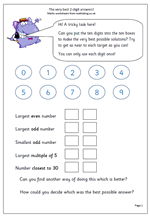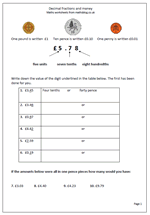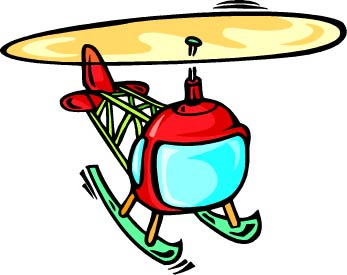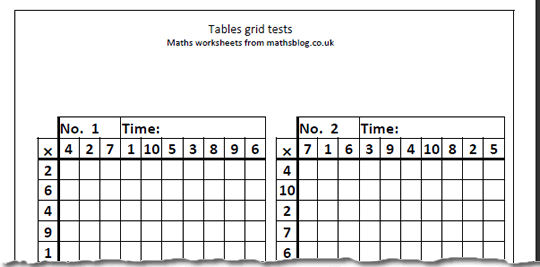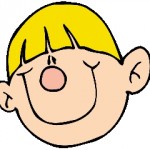 Let’s begin by looking at what is expected by the end of the Reception year – that’s children aged between 4 and 5 years old. This is sometimes called the Foundation Stage. Yes, even our 5 year olds have targets to reach!
Let’s begin by looking at what is expected by the end of the Reception year – that’s children aged between 4 and 5 years old. This is sometimes called the Foundation Stage. Yes, even our 5 year olds have targets to reach!
I will take each of the strands in turn, but as you go through them it will become clear that the most important thing of all is to talk with your children and use the vocabulary of simple maths to help them describe the world around them.
Counting and understanding number:
• Children should be able to say and use number names up to 10. A good example of this would be to join in nursery rhymes or songs such as:
“One, two three, four, five. Once I caught a fish alive.”
• Children should be beginning to count up in ones, up to 10 objects. This would be in a practical sense of counting a number of objects that they can touch (pieces of a jigsaw, coins, hats etc). Later they can count things they can see, but not touch (panes in a window, cows in a field etc).They can then begin to count down from a small number eg 5,4,3,2,1,0.
• They should be beginning to use mathematical language to compare two numbers. Words to include are: bigger/smaller, more/less, first/last.
• Recognise the numerals 1 to 9. Birthday cards with the age on is always a good starting point. Make a set of numbers from 0 to 9 on card. Pick out the numbers in a story: 3 Billie Goats Gruff etc.
Knowing and using number facts:
• Children should know one more or one less than a number between 1 and 10. In other words they know that 5 is one more than 4 etc. Again, the real world is the best learning environment – laying the table, in the kitchen etc.
Calculating:
• Children should begin to see addition as the combining of two groups of objects. (An example of this might be “Show me 3 fingers on your right hand. Show me two fingers on your left hand. How many fingers are showing altogether? Count 123….12….12345. They will need the oral prompt of “so 3 fingers and 2 fingers make 5 fingers” after the counting.)
• Children should begin to see subtraction as ‘taking away’. (When asked how many are left after eating 2 of our 5 cakes to begin with children will do this by counting how many are left. Having counted what is left, they need the reinforcement orally -“let’s say together 5 take away 2 is 3”.
• Through practical activities they will begin to use the vocabulary of addition and subtraction: add, make, more, take away, how many are left?
• A further extension is to begin to share objects into equal groups and count how many there are in each group.
Understanding shape:
• Children are expected to be able to create simple patterns. Much of this might be described as art work – using sets of shapes, printing, beads, cotton reels etc to create simple patterns and talk about them.
• Children are expected to be able to use the vocabulary of shape to describe the shape and size of solid and flat shapes: circle, triangle, square, rectangle, cube, cone and sphere. These could be shapes they make themselves or familiar shapes found around the home: mats, boxes etc.
• Use everyday words to describe the position of objects. A wide vocabulary including: over, under, above, below, next to, in front, behind, outside, inside, next to, left, right, up, down, forwards, backwards, across. Reading books are excellent for this type of work: looking at a picture in a book such as “Where’s Spot”.
Measuring:
• Children are expected to use the vocabulary of simple measurement, such as: more or less, longer or shorter, greater or smaller, heavier or lighter, thick, thin, tall, high, low, full, empty. Much of this is in the form of comparisons and needs to be done on a practical basis: a pair of balance scales and empty containers which can be filled with sand/water are really useful for this.
• Children are expected to use the vocabulary of time. They are expected to begin to know the days of the week, morning, afternoon, night, today, tomorrow, yesterday, now, soon, later, before, after, next, last. Again, story books are a superb resource such as The Very Hungry Caterpillar by E Carle. They should be beginning to use hours of the day: my bedtime is 8 o’clock etc.
Handling data:
• Children are expected to be able to sort familiar objects according to simple criteria – colour, shape, size etc. A tray of beads, lego, coins, marbles etc are all useful for this.
• They will count the number of objects which share a particular property (eg red crayons)
• They will also begin to present results of their counting using pictures or drawings
Using and applying mathematics:
• Use mathematical ideas to solve simple practical problems
• Match sets of objects to numerals
• Sort objects
• Talk about patterns in number
• Talk about how to solve a simple practical problem.
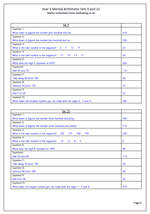 This week the mental arithmetic for Year 3 concentrates on writing whole numbers in digits, counting on and back, addition, subtraction and place value.
This week the mental arithmetic for Year 3 concentrates on writing whole numbers in digits, counting on and back, addition, subtraction and place value.